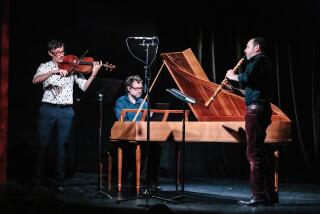Add accordion to the jazz mix
The accordion isn’t exactly one of the more common instruments in jazz. Yet in the context of the genre-shifting mix of New York’s Claudia Quintet, the accordion sounded so natural at REDCAT on Wednesday night that it’s fair to start questioning just why it doesn’t make an appearance more often.
Of course, the same can be asked of the quintet. Composed of veterans from New York City’s jazz scene, the Claudia Quintet doesn’t make its way west very often. But the audience of CalArts students and older jazz heads were treated to an evening with a versatile band that deserves mention among the top ensembles in jazz today.
Led by wily, sharp-dressed drummer John Hollenbeck, the quintet operated as a democratic platform, with each of its members given ample opportunity to shine. Ted Reichman was seated at the center of the stage, and his accordion often led the group but rarely drifted into a conventional, Eastern European sort of sound, particularly when tangling with free-flowing vibraphonist Matt Moran on the swirling melody of the night’s opener, “Sphinx.”
Though the group often swerved through dense ensemble playing that at times resembled the New Music compositions of Steve Reich, it was also perfectly capable of dropping into a funk-adjacent groove. On “Be Happy” from the quintet’s 2007 CD “For,” Hollenbeck and bassist Drew Gress locked into a heavy, metallic-edged beat before teaming with saxophonist/clarinetist Chris Speed to investigate the outer edges of Moran’s cascading vibraphone.
Hollenbeck’s nearly orchestral compositions underscored the group’s virtually telepathic interplay, but the quintet’s willingness to explore new sonic possibilities was as much of a highlight. After opening its second set with a sort of unhinged dialogue between Moran and Speed on “Royal Toast,” the group sped toward a driving cacophony with “Jazz Envy.”
As Moran hovered over his keys, using what appeared to be a children’s toy to produce an uneasy echoing effect, special guest pianist Gary Versace embarked on a rollicking free excursion that was hemmed in by Hollenbeck’s slow-building rhythm. As the song became more driving and insistent, the ensemble locked into a post-rock groove.
Occupying a style-shifting middle ground that could recall “Filles de Kilimanjaro”-era Miles Davis as adroitly as a host of influences from the world of classical and rock, the Claudia Quintet isn’t an easy group to peg. But one can hope as it continues to evolve, it will become easier to find on this side of the country.
--
More to Read
The biggest entertainment stories
Get our big stories about Hollywood, film, television, music, arts, culture and more right in your inbox as soon as they publish.
You may occasionally receive promotional content from the Los Angeles Times.











